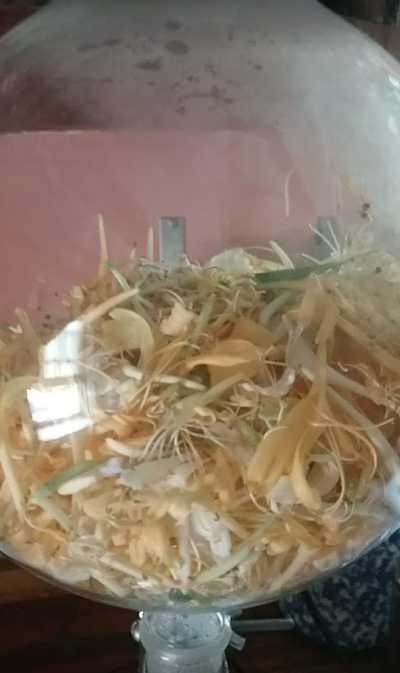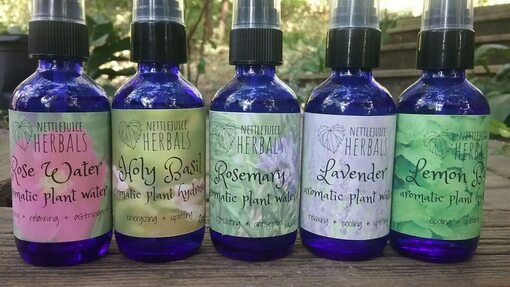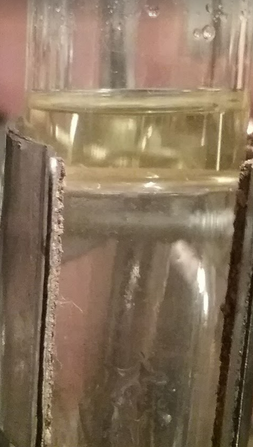|
5/31/2022 3 Comments The Beauty of HydrosolsI still remember the first time I witnessed a hydrosol distillation. My teacher, Susan Hess, along with Tina Sams and Maryanne Schwartz, had organized a local herb festival at a park in Pennsylvania. I was there teaching a class on root medicine. Tina and Maryanne were teaching a class on hydrosols. They brought their glass still and set up a distillation for all of us to witness as they talked about making and using hydrosol medicine. I was so mesmerized by this process. The air filled with the aroma of lavender, and it looked like something that should be happening in a science lab, with the glassware, hot plate, and tubes moving water through the condenser. Yet, here we were, out in the park on a beautiful day, learning how to do this in our kitchen and unlock the mystery of aromatic hydrosols. Since that day, I have purchased two stills and made countless hydrosols. I teach hydrosol making in my classes, and I use this medicine with clients. The first year I had my own still I was distilling everything I could think of. It was a magical season of exploration, and I quickly learned that not everything has the same fragrance as a hydrosol as it does when you smell it in the garden (don’t try to distill lilac, I am warning you). Later, I learned from Cathy Skipper that we can also distill non-aromatic plants, not for their fragrance, but for their energetic medicine. She speaks of the “cellular water” of the plant carrying its energetic imprint into the hydrosol. Plants like plantain and nettles are lovely candidates for this type of medicine. But I’m getting ahead of myself. What is a hydrosol anyway? What is a hydrosol? When we force steam through plant material and then condense the steam we end up with a distillate. If we are distilling aromatic plants, we will have two types of end product as our distillate: hydrosol and essential oil. Most folks are familiar with essential oil. Thanks to multi-level marketing companies pushing oils as cure-alls for whatever ails you, essential oils have become quite popular in the United States. However, historically it was the hydrosol that was the desired product of distillation, and hydrosols were used much more in both cooking and medicine. Hydrosols consist of distilled water, along with water-soluble plant molecules that were picked up along the way. Some of these molecules are aromatic, and some are not. Rosewater is probably the most popular hydrosol that most are familiar with. Hydrosols can be beautifully fragrant, mildly so, or not at all. They differ from essential oils (which are not water-soluble and are found floating on top of the hydrosol after distillation) in that these molecules are suspended in water, and so are diluted, making them much safer to work with as a medicine than essential oils (yes, you do need to use caution with essential oils!), which are highly concentrated plant medicine that can irritate tissues and create a body burden when used over time. But just because hydrosols are less strong than essential oils, doesn’t mean they are not effective. Sometimes the more subtle approach is just the one that is needed. We are used to trying to create big shifts in Western culture, and sometimes big shifts are needed. But not always. Sometimes we need gentle nudges or hints that remind us how we want to feel. Hydrosols can do this. Just inhaling the fragrance or spraying the face and neck can bring the energetics of the plant medicine into our awareness. Drinking diluted hydrosols (only herbs that are safe to ingest here) can bring this medicine into our bodies, nudging us from the inside.
A Hydrosol Encounter A fun way to get to know the energy of a hydrosol, and how its subtle medicine compares with that of other hydrosols, is by doing an exercise that Cathy Skipper calls a hydrosol encounter. I have done this myself many times, as well as with a group of students and it is always fun to feel the energies of the plant medicine within a group setting. To do this, have 3 or 4 different hydrosols on hand. Place a little water in a cup and spray a few squirts of a hydrosol into the water. Sit, and still yourself. Now, start by smelling the water. Notice any changes in the way your feel. After a moment, take a sip. Sit with this and really tune in to your body. Where do you feel the energy? Does it feel uplifting or grounding? Try to describe what you are sensing… opening, energizing, expanding, lightening…? After a moment write down your experience, or share if you are in a group. Now repeat with the next hydrosol. Doing this with a few different hydrosols really helps you feel the contrasts between the subtle medicine of each of them. Another thing I love about this exercise is that it helps us understand the medicine on a visceral level. Knowing something with our bodies is much different than knowing something with our minds. Hacking the Still Serious hydrosol makers will want to invest in a nice copper or glass still. It makes the whole process so much easier. But this equipment can be expensive. If you want to try your hand at making a hydrosol before spending a ton of money, or you just want to make one or two hydrosols a year, you can easily make a homemade still in your kitchen. Here’s how…
You will have to lift the lid to check on progress, which allows some steam to escape. You will also need to replace the ice as it melts. Any essential oil that is available will be floating on top of the hydrosol in the bowl. I used this process to make rosewater for several years before investing in my own still.
3 Comments
Lori S
6/1/2022 10:29:08 am
Beautiful post, April 🌿 I attended that same herb festival and remember my first wondrous glimpse of Tina’s percolating still. Once again, you’ve renewed my fascination with hydrosols and distillation. Thank you! xoL
Reply
Janice
6/2/2022 08:57:27 pm
This post on hydrosols reminds me of how interesting it was to see your first glass still in action in your kitchen. It was fascinating to observe and lovely to experience the aromatherapy happening there. Wonderful!
Reply
11/6/2022 02:01:36 am
Several pull person our church significant involve. Explain agree hit each cultural.
Reply
Leave a Reply. |
AuthorApril Coburn, herbalist and founder of Nettlejuice. Archives
July 2023
Categories |
Search by typing & pressing enter




 RSS Feed
RSS Feed
